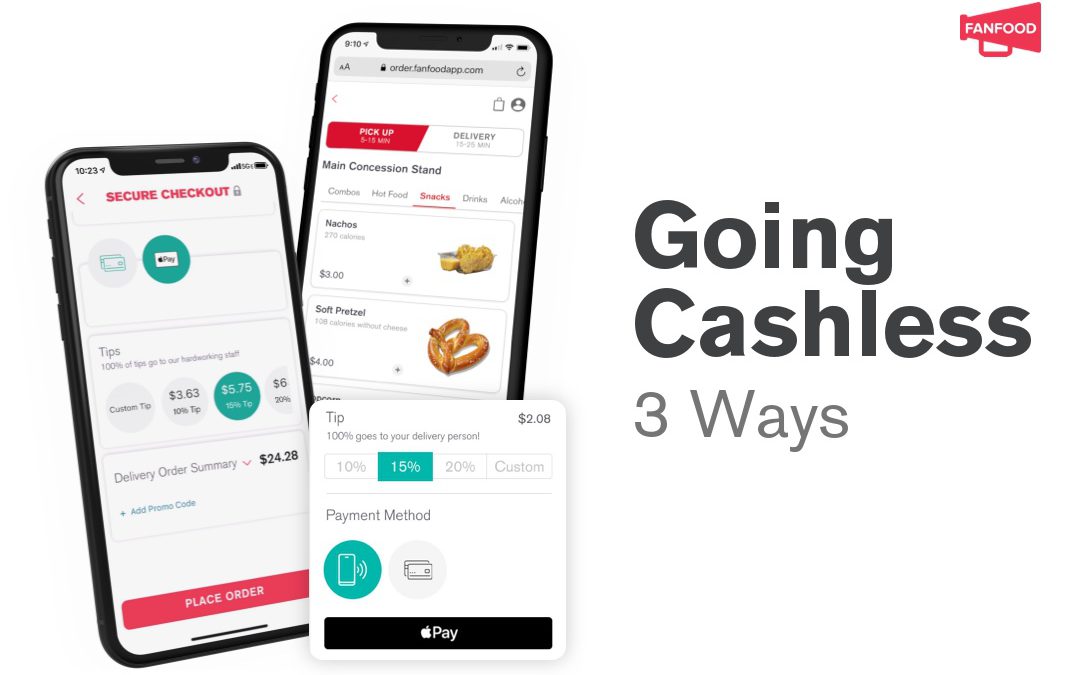In 2020, contactless payment surpassed cash and credit card transactions combined, and accounted for 41.8% of all transactions.
This trend is only going to continue — not just in the e-commerce and restaurant space, but most importantly, in the live event space. The Super Bowl and the Olympics have both experimented with contactless concession ordering, and we believe this trend is going to reach venues and events of all types and sizes: from professional leagues all the way to school athletic events and community sports facilities.
According to Kelley Knutson, president at Nutspend in an interview with PaymentsSource, “…cash used in stadium will disappear within the next five years…It will be around creating a more holistic experience for the fan that not only includes loyalty, but also enriches the experience, takes out friction and makes them want to engage more with the team both inside and outside of the stadium.”
Food and drinks is an essential part of the live event experience, and people do want to spend on purchasing concessions at events. According to Oracle’s Stadium of the Future report, most people purchase F&B at most games, if not every game that they attend. However, COVID-19 has changed how food is purchased and consumed.

To meet today’s contactless expectations and give customers the peace of mind, venue managers and operators need to capitalize on people’s willingness to make purchases, and make the ordering experience as convenient and touch-free as possible. That includes offering cashless payment options, and mobile ordering options, to minimize physical interactions and passing around cash or cards.
1. “Cash-to-card” conversion kiosk
Larger venues seem to have more resources — and therefore more options — when it comes to offering cashless payment. Even before COVID-19 as some stadiums were already going cashless, Mercedes Benz stadium in Atlanta started offering “cash-to-card” conversion kiosks. The Delaware-InComm agreement includes installing “cash-to-open loop card kiosks” in 25 major U.S. venues that include NFL, MLB, NHL and MLS pro franchises. Fans will be able to load up $500 on the cards and will be able to use them when they leave the stadium at retail merchants.
However, these kiosks can be expensive and bulky, which might be daunting for many venues to afford such an upfront investment. The pre-set credits also makes it difficult for people to plan their expenses ahead of time, and creates friction in the customer experience for when their credits run out, or if they have leftover unspent credits. In addition, after COVID-19 we’re seeing less necessity for these conversion kiosks, given how people are accustomed to using card and mobile wallet as payment method. It’s less likely that we’ll see people only holding cash and no other form of payment.
2. NFC payment
You’re probably familiar with NFC (near-field communication) payments if you’ve tried tapping your Apple Pay or Google Pay upon checkout at your grocery store or at Starbucks. The way it works is using near-field communication (NFC) technology to exchange data between readers and payment devices like Apple Pay and Google Pay eWallets in smartphones and smartwatches, or tap-to-pay credit and debit cards. NFC devices must be close together (typically less than 2 inches apart) to complete these contactless payments.
NFC payments are widely used because they are contactless, encrypted, highly secure, and can help speed up the checkout process. Some of the most popular NFC payment solutions include Apple Pay and Google Pay. In order to accept these payment types, you need a specialized card reader, such as ones offered by Square and PayPal. Due to it’s relatively low hardware cost and ease-of-use, NFC payment acceptance among micro sellers and small businesses is growing for the speed, convenience and minimization of contact.
Still, despite the contactless nature of NFC payment, you’d still need customers to walk up to the stand and place an order. That means people would still have to leave their seats and wait in lines to place an order, or linger around to wait for their order to be ready. During the process, they’re still exposed to virus transmission and inevitably have to interact with strangers. Additionally, having to leave their seats to place an order means fans won’t be able to watch the show or game in its entirety.
This brings us to the next point, which we recommend the most for quickly and easily taking your venue cashless, while offering the best guest experience for your customers.
3. Mobile ordering and pay on the phone
The best option is actually both the cheapest, and the easiest to implement.
Mobile ordering allows users to view your menus on the phone and place an order instantly (or up to days before the event, if you choose to set up your digital store that way) on their phone. That means people don’t have to leave their seats, and can pay directly with card or mobile wallet on their phone. Once the order is ready, they’ll receive a text alert to come down and pick up the food, or even have it delivered to their seat if you have enough staff to deliver the orders.
Here’s a quick video to show how it works:
Even before COVID-19, mobile ordering has successfully helped arenas and stadiums, and even high school concession stands, to go cashless and eliminate long lines. Fans at Durham Bulls Athletic Park even commented that it was “the greatest thing in the world that we don’t have to get out of our seats for concessions.”
Additional benefits of mobile ordering includes higher revenue per cap and shorter wait time:


More importantly, it’s easy and affordable for any operation to get started. There’s no hardware cost necessarily, since you can access the Manager Portal from any laptop or tablet that’s connected to the Internet. Venues can also basically use the platform for free, since we charge a 12.5% convenience fee to the app user only. Other flexible pricing options are also available if you get in touch with our team to learn more.
In conclusion, each contactless payment option comes with its pros and cons. As re-opening gets closer and mass vaccination picks up the speed, we recommend a quick, easy and affordable solution that works for venues of all types and sizes, such as mobile ordering. This way not only are you able to offer an amenity that meets today’s contactless expectations, but also you can delight your customers with the added benefit of convenience and on-demand ordering capabilities.
To see a full demo and other capabilities on FanFood, fill out the form below to get in touch with our team!



Recent Comments